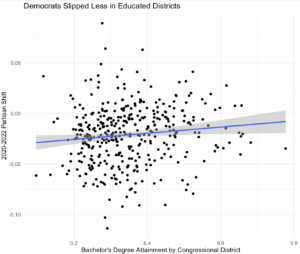The strength of education polarization broke historical precedent in 2022 US House races, overpowering “down-ballot lag,” which occurs when changes in partisan patterns appear first at the presidential level, to drive continued realignment during this midterm cycle. Education polarization drove rapid and notable realignment between the 2012 and 2020 presidential elections, and the 2022 midterms indicate America is heading towards a future where political coalitions are driven by an increasingly pronounced divide in educational attainment.
Recently, education polarization has been making a lot of news. Before the midterm elections, I wrote about how the overturning of Roe v. Wade could intensify political realignment during the 2022 midterms. Abortion is a very educationally polarized issue. In 2020, President Joe Biden defeated Donald Trump by 24% among voters who attained at least a bachelor’s degree. However, these same voters supported pro-choice positions over pro-life positions by a 34% margin in polling: there are still plenty of educated voters who support abortion rights but voted for Trump in 2020. Evidence suggests that Trump voters in more educated areas tend to be disproportionately likely to support pro-choice positions in abortion referendums, and abortion substantially rose in salience in the leadup to November’s midterm elections.
Looking Back at OH-01 and TX-15
In my midterm preview article, I focused on two house districts likely to experience the effects of last summer’s Jackson v. Dobbs decision. Voters in OH-01, represented by pro-life incumbent Republican Steve Chabot, have a robust 45.0% bachelor’s degree attainment rate (well above the national average of 33.7%). Democrats made gains in suburban districts around the nation since 2012, controlling 36 of the 38 most educated house districts in the US after the 2020 general election. After re-drawing TX-15 as a Trump+3 district, Republicans were optimistic about their chances of flipping this ~80% Hispanic seat. Trump gained substantially in the Rio Grande Valley in 2020, prompting incumbent Representative Vicente González to flee to neighboring Biden+16 TX-34.
Warren County, which composes about a third of OH-01, consists of predominantly white, affluent, and highly educated Cincinnati suburbs and exurbs. The county is one of the most “ancestrally Republican” in the nation, as Biden only won 34.4% of the two-party vote in 2020 despite demographic modeling predicting Biden would win around 53.0%. It ultimately shifted away from Chabot by 7 points relative to the nation as a whole from 2020 to 2022. Due to his weakness in Warren County and other similar areas in Hamilton County, Chabot lost re-election by 5% (despite FiveThirtyEight’s Likely R rating). Although FiveThirtyEight gave progressive Democrat Michelle Vallejo a slight edge in their TX-15 prediction, she was crushed by Republican Monica de la Cruz by a >8% margin. Hispanic voters support abortion rights at a significantly lower rate than their partisanship implies, meaning that Democrats stood to gain less in TX-15 from the increased salience of abortion.
Education Polarization Increased Around the Nation
OH-01 and TX-15 serve as exceptional examples of how education polarization triumphed over conventional down-ballot lag and flipped congressional seats faster than up-ballot results indicated was likely. But, there is ample evidence that this trend occurred around the nation, shattering historical precedent. In the past, midterm house results tend to revert from the prior presidential trend. For example, when calculating calculate the partisan lean of districts for a 2022 US House race, a forecaster would take a weighted average of the 2020 and 2016 presidential results. So if a district shifted from R+6 in 2016 to R+3 in 2020, the partisan lean for that district in 2022 would end up somewhere around R+4. This phenomenon is attributed to “down-ballot lag,” a concept where ancestral voters tend to back down-ballot candidates from their party even after they abandon their party’s presidential nominee. Considering that most ancestrally Democratic areas are more diverse and have lower educational attainment, while most ancestrally Republican areas have higher educational attainment, one might expect that education polarization decreased between 2020 and 2022 (comparing presidential results to house results, at least). Instead, Democrats were more successful in educated districts in 2022 US House races relative to 2020 Presidential results.

The gap was especially pronounced between the 50 most educated districts and the 50 least educated districts in the nation—Democratic house candidates enjoyed much more upside in the higher education districts.

The differences are slight, but statistically significant. And remember, down-ballot lag works against education polarization in this case, stunting its effect. Education polarization is continuing to grow (even taking Trump himself off the ballot), and very well could come to define another decade of partisan realignment.
Author’s Notes:
FiveThirtyEight, confirmed by in-house analysis, found a historical presence of down-ballot lag and partisan reversion in midterm US House elections prior to 2022. In 2022, 2016 presidential partisanship was not a statistically significant predictor of house results in either direction.
Although an “apples-to-apples” comparison of 2020 house results to 2022 house results would be ideal, redistricting makes this approach have its own problems.
District bachelor’s attainment rate was a statistically significant predictor of the 2020 Presidential to 2022 US House partisan shift with a p-value of .0188.